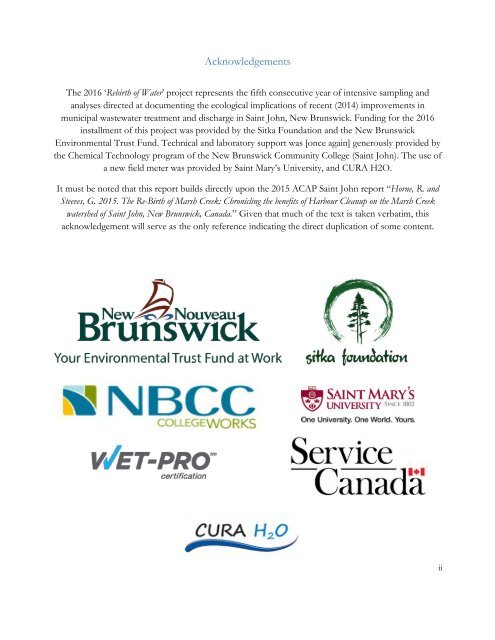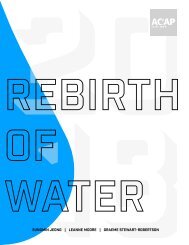Rebirth of Water Report 2016-2017
Marsh Creek, which is the largest watershed in greater Saint John, has been the recipient of centuries of untreated municipal wastewater deposition. Offensive odours, unsightly sanitary products and the threat posed by various human pathogens, resulting largely from the ~50 sewage outfalls in the lower reaches of Marsh Creek and the Saint John Harbour, have caused most residents to abandon the wellness of the watercourse. ACAP Saint John, a community-based ENGO and champion of the Harbour Cleanup project, has been conducting water quality monitoring and fish community surveys in the watershed since 1993 with the view towards someday restoring the ecological integrity of this forgotten natural asset.
Marsh Creek, which is the largest watershed in greater Saint John, has been the recipient of centuries of untreated municipal wastewater deposition. Offensive odours, unsightly sanitary products and the threat posed by various human pathogens, resulting largely from the ~50 sewage outfalls in the lower reaches of Marsh Creek and the Saint John Harbour, have caused most residents to abandon the wellness of the watercourse. ACAP Saint John, a community-based ENGO and champion of the Harbour Cleanup project, has been conducting water quality monitoring and fish community surveys in the watershed since 1993 with the view towards someday restoring the ecological integrity of this forgotten natural asset.
You also want an ePaper? Increase the reach of your titles
YUMPU automatically turns print PDFs into web optimized ePapers that Google loves.
Acknowledgements<br />
The <strong>2016</strong> ‘<strong>Rebirth</strong> <strong>of</strong> <strong>Water</strong>’ project represents the fifth consecutive year <strong>of</strong> intensive sampling and<br />
analyses directed at documenting the ecological implications <strong>of</strong> recent (2014) improvements in<br />
municipal wastewater treatment and discharge in Saint John, New Brunswick. Funding for the <strong>2016</strong><br />
installment <strong>of</strong> this project was provided by the Sitka Foundation and the New Brunswick<br />
Environmental Trust Fund. Technical and laboratory support was [once again] generously provided by<br />
the Chemical Technology program <strong>of</strong> the New Brunswick Community College (Saint John). The use <strong>of</strong><br />
a new field meter was provided by Saint Mary’s University, and CURA H2O.<br />
It must be noted that this report builds directly upon the 2015 ACAP Saint John report “Horne, R. and<br />
Steeves, G. 2015. The Re-Birth <strong>of</strong> Marsh Creek: Chronicling the benefits <strong>of</strong> Harbour Cleanup on the Marsh Creek<br />
watershed <strong>of</strong> Saint John, New Brunswick, Canada.” Given that much <strong>of</strong> the text is taken verbatim, this<br />
acknowledgement will serve as the only reference indicating the direct duplication <strong>of</strong> some content.<br />
ii


















